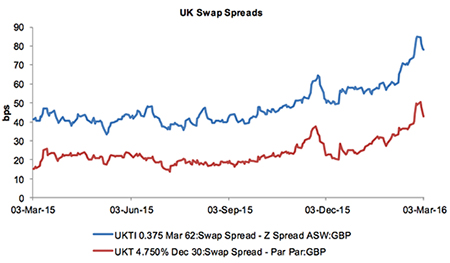Gilt-swap spreads widen: An opportunity for pension schemes?
From the blog: Investing in UK government bonds or using interest rate swaps are two of the more popular ways by which defined benefit pension schemes aim to match their liabilities.
Interest rate swaps have historically been more capital-efficient, as you can enter into a swap under no obligation to commit all the cash required to buy the equivalent gilt outright, allowing pension schemes to leverage their assets.
To achieve the equivalent leverage using gilts, a gilt repurchase agreement can be used. Unlike a swap, a repurchase agreement needs to be renewed every three to 12 months. This renewal is known as ‘rolling’ and comes with roll-risk.
At the moment however, the yield on gilts bought with cash is higher than that available on an interest rate swap with equivalent long-dated maturities.
This difference is termed the 'gilt-swap spread', and taking advantage of it represents a great opportunity for pension funds looking to match their liabilities.
Source: Barclays Live 1 year to March 2015
What is the opportunity?
On longer-dated maturities, index-linked gilt yields have recently been trading at roughly 80 basis points higher than swap yields.
For a typical UK DB pension scheme with liabilities of about £500m and a duration of 20 years, an additional yield of 80bp is equivalent to about £80m – no small sum.
How can schemes benefit?
While schemes need to think carefully about how best to take advantage of the higher yield, there may be a way to have your cake and eat it.
Pension schemes that have the cash available from improved funding levels and are on a derisking journey can move out of swaps and buy the gilts outright as a smarter way of derisking.
For schemes looking to maintain their exposure to growth assets, another solution involves shifting any existing leverage from their matching portfolio to their growth portfolio.
For example, schemes could move out of swaps and buy the gilts outright, funding the trade by selling equities and adding some equity futures to maintain equity exposure.
In this solution, net leverage stays the same. And the scheme can still benefit from higher gilt yields without taking any additional roll-risk on the repos.
In all situations, it is important that schemes think carefully about the best way to take advantage of these opportunities and risks associated.
Cai Rees is client investment strategist at asset manager SEI


